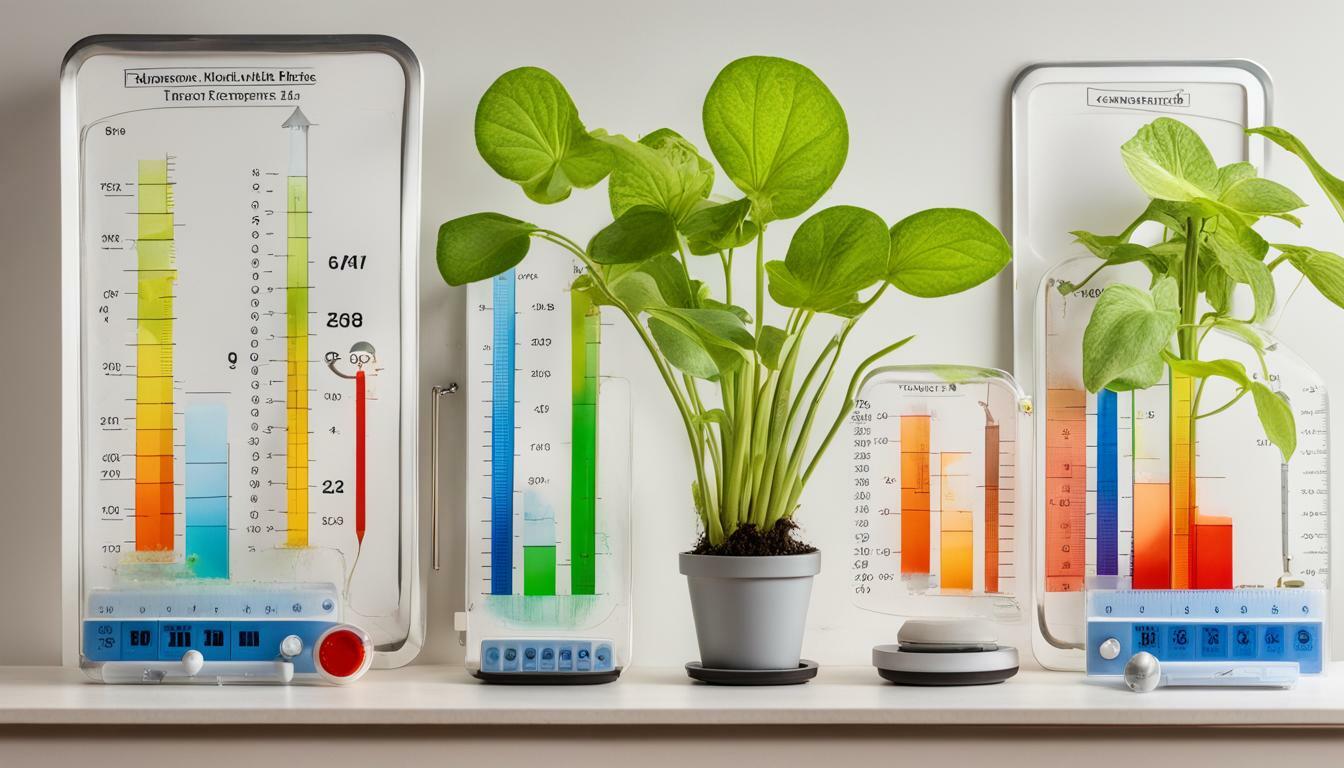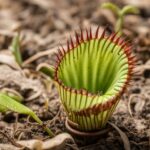As a Venus Flytrap owner, you want to ensure that your plant thrives and remains healthy. One of the most crucial factors that affect the growth and overall well-being of Venus Flytraps is temperature. Understanding the best temperature conditions for your Venus Flytrap and providing the right environment is paramount to its survival and longevity.
When it comes to Venus Flytrap temperature care, there are several aspects to consider, including temperature requirements, optimum temperature range, factors affecting temperature preferences, and how to create the right temperature environment.
Key Takeaways:
- Venus Flytraps have specific temperature requirements that are crucial for their growth and well-being.
- The ideal temperature range for Venus Flytraps is between 70-85°F during the day and 50-60°F at night.
- Natural habitat, seasonal variations, and location are some of the factors that affect Venus Flytrap temperature preferences.
- Creating the right temperature environment for your Venus Flytraps involves regulating temperature levels, providing adequate humidity, and preventing extreme temperatures.
- Regular temperature monitoring is essential to ensure the best possible care for your Venus Flytraps and identify any potential issues.
Venus Flytrap Temperature Requirements
Venus Flytraps are unique plants that require specific temperature conditions to thrive. As a responsible Venus Flytrap owner, it is important to understand the temperature requirements of these fascinating plants to ensure their growth and overall well-being.
The recommended temperature for Venus Flytraps is between 70°F and 85°F (21°C to 29°C) during the day and between 55°F and 65°F (13°C to 18°C) at night. It is important to provide consistent temperature conditions within this range to promote healthy growth and prevent stress on the plants.
Venus Flytraps are native to the subtropical wetlands of the Southeastern United States, where they are exposed to a wide range of temperatures throughout the year. They are adapted to endure both hot and cold temperatures, but extreme conditions can be harmful to their delicate ecosystem.
When temperatures drop below 50°F (10°C), Venus Flytraps enter a dormant state and stop growing until conditions improve. Conversely, when temperatures exceed 95°F (35°C), the plants can become stressed and may die if they do not receive adequate water and cooling.
In addition to temperature, other factors that can affect Venus Flytrap growth and health include humidity, light, and soil conditions. It is important to monitor these factors as well and make adjustments as necessary to provide the best possible care for your Venus Flytraps.
Optimum Temperature for Venus Flytraps
Venus Flytraps are notorious for their sensitivity to temperature conditions, which can significantly influence their growth and well-being. To ensure your Venus Flytrap thrives, it’s essential to maintain an ideal temperature range that meets its requirements.
The ideal temperature range for Venus Flytraps falls between 70-85°F during the day and around 50-60°F at night.
While Venus Flytraps can tolerate a broader temperature range, deviations from their optimum temperature can cause several issues that could compromise their health and lifespan. For example, high temperatures can cause the leaves to wither and turn brown, while low temperatures could slow down growth and cause black spots to appear on the leaves.
It’s worth noting that the optimum temperature for Venus Flytraps can vary depending on their natural habitat and seasonal variations. For instance, Venus Flytraps growing in hot, humid environments may tolerate slightly higher temperatures, while those growing in cooler environments may require more consistent temperatures.
To ensure that your Venus Flytrap thrives, it’s best to monitor the temperature closely and make any necessary adjustments to ensure the ideal temperature range is maintained. This may involve placing your Venus Flytrap in a location that receives consistent sunlight, avoiding direct exposure to harsh sunlight, and providing adequate ventilation to prevent overheating.
Factors Affecting Venus Flytrap Temperature Preferences
Venus Flytraps have specific temperature preferences that are influenced by various factors. Understanding these factors can help you provide the best possible care for your plant.
Natural Habitat
Venus Flytraps are native to the subtropical wetlands of the southeastern United States, where temperatures can range from 20°C (68°F) in the winter to 35°C (95°F) in the summer. Therefore, they thrive in warm and humid conditions.
Seasonal Variations
Venus Flytraps have evolved to adjust to the changing seasons. They become dormant in the winter, where temperatures drop below 10°C (50°F) and require less light, water, and nutrients. In contrast, during the active growing season, they require higher temperatures of around 28°C (82°F) and regular watering.
Cultural Practices
Environmental factors such as light, humidity, watering practices, and potting soil also influence Venus Flytrap temperature preferences. For example, placing your plant in direct sunlight can cause overheating, while inadequate humidity levels or overwatering can lead to chilling injury. Therefore, creating the right conditions for your plant is essential and monitoring environmental changes can help you adjust your care practices.
Creating the Right Temperature Environment for Your Venus Flytraps
Now that you understand the importance of temperature conditions for Venus Flytraps, it’s time to create the ideal temperature environment for your plant. Whether you are growing the plant indoors or outdoors, following the right temperature guide will help your Venus Flytrap to thrive and grow.
Firstly, it’s important to note that Venus Flytraps are native to hot and humid environments, so maintaining humidity is essential to their well-being. Use a humidifier to keep the air moist around the plant, especially if you live in an arid climate.
The ideal temperature range for Venus Flytraps is between 70°F and 85°F during the day and 55°F to 65°F at night. Avoid exposing the plant to temperatures below 40°F or above 95°F for extended periods as it can negatively impact the plant’s growth and overall health.
To maintain the temperature conditions, place your Venus Flytrap in a location that receives bright and indirect sunlight. Avoid exposing the plant to direct sunlight, as this can cause the temperature to rise too quickly and damage the plant.
If you are growing the Venus Flytrap indoors, place it in a room with plenty of natural light, such as a south-facing window. Alternatively, use grow lights to provide the necessary light spectrum for photosynthesis.
If you are growing the Venus Flytrap outdoors, choose a location that receives at least four hours of indirect sunlight each day and avoid placing the plant in a windy area, as this can cause the temperature to fluctuate rapidly.
Finally, remember to maintain a consistent temperature environment by monitoring the temperature with a thermometer regularly. This will help you to make any necessary adjustments to the temperature conditions quickly to prevent any damage to the plant.
Protecting Venus Flytraps from Extreme Temperatures
While Venus Flytraps are hardy plants, extreme temperature conditions can be detrimental to their health. Frost and excessive heat are especially dangerous and can cause permanent damage if not addressed promptly. To provide the best temperature care for your Venus Flytraps, follow these tips:
1) Move Your Venus Flytraps Indoors During Extreme Seasons
If you live in an area with extreme temperatures, such as very hot or very cold climates, consider moving your Venus Flytraps indoors during these seasons. This can help protect them from the harsh elements and maintain a more stable temperature environment.
2) Cover Your Venus Flytraps During Frost
If you expect frost in your area, cover your Venus Flytraps with a protective layer, such as a frost cloth, to shield them from the cold. This will help prevent frost damage and keep your plants healthy.
3) Water Your Venus Flytraps Regularly During Hot Seasons
During hot seasons, Venus Flytraps may need more water than usual to prevent dehydration. Make sure to water your plants regularly and keep the soil moist. However, avoid over-watering, as this can also be harmful to your Venus Flytraps.
4) Provide Shade During Excessive Heat
When temperatures rise above 90°F, Venus Flytraps can start to experience heat stress. To prevent this, provide shade for your plants by placing them under a tree or covering them with a shade cloth. This will help keep the temperature low and protect your Venus Flytraps.
By following these tips, you can protect your Venus Flytraps from extreme temperature conditions and provide them with the best possible care.
Monitoring Temperature Levels for Optimal Venus Flytrap Care
As a conscientious Venus Flytrap owner, you should monitor the temperature levels of your plants to ensure they remain in the ideal range for their optimal growth and health.
Checking the temperature regularly is particularly important if you live in an area with fluctuating weather conditions that can affect the indoor or outdoor environment where your plants are situated.
When monitoring the temperature, you should also be aware of the factors that affect the preferences of Venus Flytraps. For example, they prefer lower temperatures during the winter months, and higher temperatures during the summer months.
To achieve the best temperature conditions for your Venus Flytraps, you should consider investing in a thermometer to measure the temperature in the immediate surroundings, such as the terrarium or greenhouse, where your plants are located.
If you notice that the temperature is outside the recommended range, you can take steps to adjust the conditions, such as by adding insulation to a greenhouse, moving plants to a different location, or increasing/decreasing light exposure.
Keep in mind that maintaining the ideal temperature environment is just one aspect of Venus Flytrap care. Other factors, such as water, soil, and fertilization, also play a critical role in their growth and health.
By monitoring the temperature levels and making necessary adjustments, you can ensure that your Venus Flytraps remain healthy and continue to thrive in your care.
Conclusion
Caring for Venus Flytraps can be a rewarding and fascinating experience, but it requires dedication and attention to detail. One of the most critical factors in ensuring the well-being of your Venus Flytraps is providing them with the right temperature conditions.
By understanding the best temperature conditions for Venus Flytraps, you can create the ideal environment for them to thrive. Remember that Venus Flytraps require warm temperatures, preferably between 70°F and 90°F, and relatively high humidity.
Regular monitoring is essential
It is crucial to monitor the temperature levels regularly to ensure that your Venus Flytraps are not exposed to excessive heat or cold. Extreme temperatures can be detrimental to their health and cause significant damage, so it is vital to take steps to protect them from extreme weather conditions.
Creating the ideal environment
To create the ideal environment for your Venus Flytraps, consider factors such as lighting, humidity, and soil type. By following the right guidelines and strategies, you can provide the best temperature conditions for your Venus Flytraps and promote their growth and overall well-being.
Remember that caring for Venus Flytraps is a constant learning process. By incorporating the information and strategies outlined in this article, you can provide the best possible care for your Venus Flytraps and enjoy their unique beauty and characteristics for years to come.
Can Incorrect Temperature Conditions Cause Diseases in Venus Flytraps?
Incorrect temperature conditions can indeed lead to common diseases affecting venus flytraps. These incredible carnivorous plants require specific temperature ranges to thrive. Extreme heat or cold can weaken their immune systems, making them more susceptible to diseases. Maintaining the correct temperature is essential for the health and well-being of Venus Flytraps.
FAQ
Q: What temperature range is best for Venus Flytraps?
A: Venus Flytraps thrive in temperatures between 70-90 degrees Fahrenheit (21-32 degrees Celsius).
Q: Can Venus Flytraps tolerate colder temperatures?
A: While Venus Flytraps can tolerate brief periods of colder temperatures down to 20 degrees Fahrenheit (-6 degrees Celsius), prolonged exposure to freezing temperatures can be fatal.
Q: What happens if Venus Flytraps are exposed to temperatures above 90 degrees Fahrenheit?
A: Excessive heat can cause stress and damage to Venus Flytraps, leading to wilting, browning, and potentially death. It is important to protect them from extreme heat.
Q: Do Venus Flytraps have specific temperature preferences?
A: Yes, Venus Flytraps prefer temperatures around 80 degrees Fahrenheit (27 degrees Celsius), but they can still grow and survive within the recommended range of 70-90 degrees Fahrenheit.
Q: How can I create the right temperature environment for my Venus Flytraps indoors?
A: You can use a terrarium or indoor grow lights to maintain a stable temperature range. It’s important to avoid placing them near drafty windows or heating vents.
Q: How do I protect my Venus Flytraps from frost or cold weather?
A: During colder months, it’s best to bring your Venus Flytraps indoors or provide them with additional protection, such as covering them with a frost cloth or moving them to a sheltered area.
Q: Should I monitor the temperature levels regularly for my Venus Flytraps?
A: Yes, regular temperature monitoring is essential to ensure that your Venus Flytraps are within the optimal range. This will help you identify any temperature-related issues and take appropriate action.











